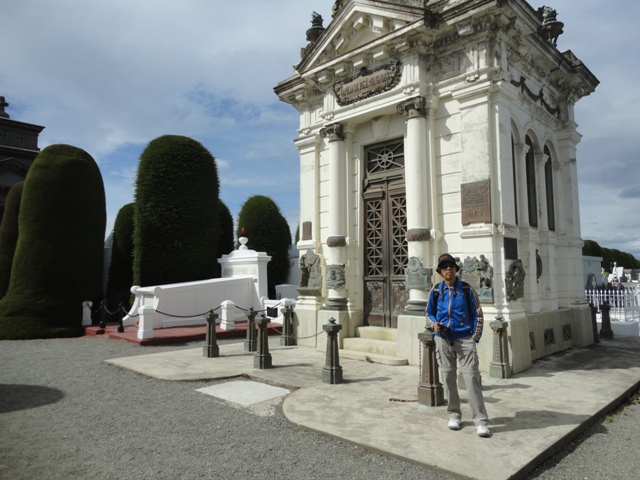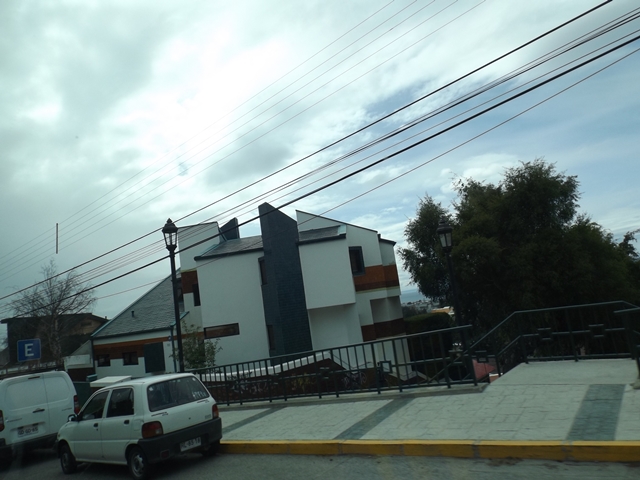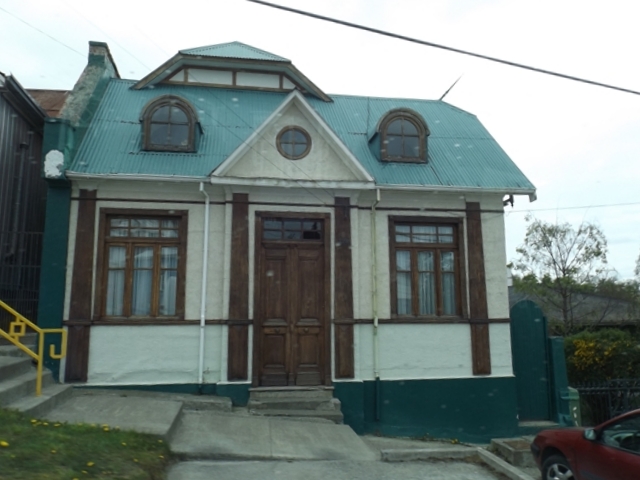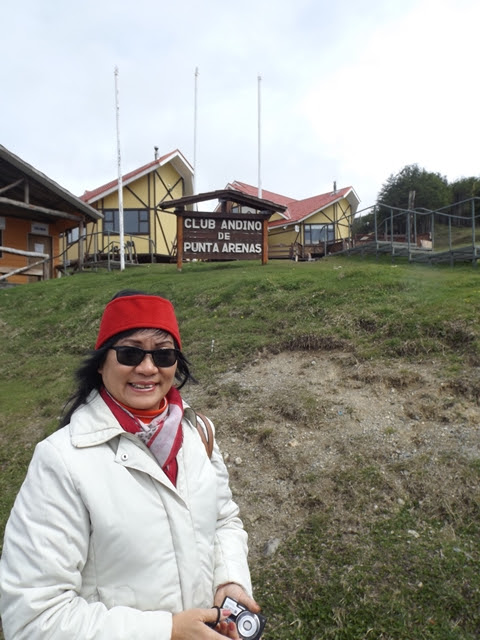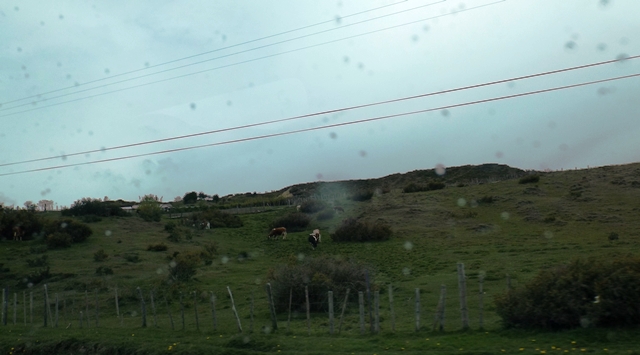chào mừng du khách
mùa Xuân hoa vàng nở rộ
Cổ thụ có giáng đăc biệt
Tượng Ferdinand Magellan (1490-1521)
Ông là một nhà thám hiểm hàng hải người Bồ Đào Nha.Chuyến hải hành trong khoảng thời gian 1519–1521 của Magellan đã đi vào lịch sử như là chuyến đi đầu tiên bằng đường biển của con người từ Đại Tây Dương đến Thái Bình Dương (cái tên có nghĩa "biển bình yên" này được đặt bởi Magellan; đồng thời nơi nối giữa hai Đại dương được mang tên Eo biển Magellan), và là chuyến đi đầu tiên băng qua Thái Bình Dương. Chuyến đi này cũng đánh dấu sự kiện con người lần đầu tiên đi vòng quanh Trái Đất thành công,
Để kỷ niệm 100 năm
nhiều cây có giáng đặc biệt quá!

nhìn bàn chân !
hoa vàng tươi mát
Important Characters
Relevant figures in the history of Punta Arenas are buried in the cemetery of that city. It is important to mention the chapels of the great families of that epoch such as Menèndez-Behety, Braun Hamburger, Blanchard, Greenshields, Kusanovic and Menèndez-Montes. Menèndez-Behety was one of the most influential families during that time and they founded several companies and acquired large tracts of land in the Chilean Patagonia.
The Legends of the Cemetery
The cemetery of Punta Arenas is well known because of its attractive legends that transform the place into a magical environment of mystery. What do people say?
- When Sara Braun gave everything for building the entrance of the cemetery, she asked for something. After her death, the central door of the cemetery had to be closed forever. Nowadays, that door is still closed and has not been opened since Sara Braun's death.
- Another known legend of the cemetery is the one concerning the “Indio Desconocido”. Everything started in 1930 when an Indian died in the Island called Diego de Almagro. The Indian was buried in the cemetery due to a donation from the administration of the same place. After twenty years, someone discovered several candles and coins around the grave. The years passed by and in 1968 the grave were plenty of papers demonstrating gratitude for being helped by the Indian. Moreover, a woman named Magdalena Vrsalovic decided to donate the coins, in order to help the Cruz Roja of Punta Arenas, a Chilean Institution that helps the community in case of difficulties. Therefore, Magdalena and other people agreed to build a monumental grave with the figure of the Indian made byEdmundo Casanova.
cypress khổng lồ
nhìn xuống vịnh thật đẹp mắt
vào dinosaure parc
trên đường trở về tàu
nhiều chim quá
phong cảnh thiên nhiên tuyệt đẹp
*************************
Punta Arenas
Bách khoa toàn thư mở Wikipedia
| Punta Arenas Magallanes | ||
|---|---|---|

Quang cảnh thành phố Punta Arenas. In the background the Strait of Magellan and the north bờ biển của Tierra del Fuego (Isla Grande De Tierra del Fuego)
| ||
| ||
 | ||
| Location in Chile | ||
| Tọa độ: 53°10′N 70°56′T | ||
| Country | Chile | |
| Region | XII - Magallanes y Antártica Chilena | |
| Province | Magallanes | |
| Founded as | Punta Arenas | |
| Foundation | ngày 18 tháng 12 năm 1848 | |
| Chính quyền | ||
| • Mayor | Vladimiro Mimica (2008 -) | |
| Diện tích | ||
| • Tổng cộng | 17.526,3 km2 (67,669 mi2) | |
| Dân số (2002) | ||
| • Tổng cộng | 154.000 | |
| • Mật độ | 6,8/km2 (180/mi2) | |
| Múi giờ | (UTC-4) | |
| 6200000 | ||
| Thành phố kết nghĩa | Lỗi Lua trong Mô_đun:Wikidata tại dòng 98: attempt to concatenate local 'label' (a nil value). | |
| Trang web | http://www.puntaarenas.cl | |
Đối với các định nghĩa khác, xem Magellan.
Punta Arenas là thành phố ở phía nam Chile, thủ phủ của vùng Magallanes y La Antárctica Chilena. Thành phố Punta Arenas có diện tích 17.526,3 km2 km², dân số 154.000 người (2002). Punta Arenas nằm ở bên eo biển Magellan, là một trong những thành phố cực nam của thể giới. Đây là một trung tâm thương mại quan trọng của Chile. Punta Arenas cũng là trung tâm ngành dầu khí ở quần đảo Tierra del Fuego gần đó. Punta Arenas đã được thành lập năm 1849 để củng cố tuyên bố chủ quyền của Chile đối với eo biển Magellan. Thành phố này từng là một nơi cung cấp nhiên liệu cho tàu bè trước khi có kênh đào Panama. Năm 1927, nó được đổi tên thành Magallanes, nhưng tên ban đầu đã được phục hồi năm 1938.
Khí hậu[sửa | sửa mã nguồn]
| [ẩn]Dữ liệu khí hậu của Punta Arenas, Chile (1970–2000) | |||||||||||||
|---|---|---|---|---|---|---|---|---|---|---|---|---|---|
| Tháng | 1 | 2 | 3 | 4 | 5 | 6 | 7 | 8 | 9 | 10 | 11 | 12 | Năm |
| Cao kỉ lục °C (°F) | 26.2 | 25.4 | 24.5 | 19.2 | 24.0 | 20.0 | 21.2 | 23.2 | 19.0 | 21.2 | 24.4 | 25.9 | 26,2 |
| Trung bình cao °C (°F) | 14.3 | 14.0 | 12.3 | 9.7 | 6.5 | 4.1 | 3.7 | 5.2 | 7.7 | 10.2 | 12.2 | 13.5 | 9,4 |
| Trung bình ngày, °C (°F) | 10.5 | 10.2 | 8.7 | 6.5 | 3.8 | 1.7 | 1.3 | 2.4 | 4.3 | 6.5 | 8.4 | 9.7 | 6,1 |
| Trung bình thấp, °C (°F) | 6.8 | 6.6 | 5.2 | 3.4 | 1.2 | −0.9 | −1.1 | −0.1 | 1.2 | 3.0 | 4.7 | 6.0 | 3,0 |
| Thấp kỉ lục, °C (°F) | −1.5 | −0.4 | −4 | −13 | −14 | −11.2 | −15 | −11.6 | −9.5 | −5 | −2.5 | −1 | −15 |
| Giáng thủy mm (inches) | 41.7 (1.642) | 31.2 (1.228) | 38.1 (1.5) | 40.2 (1.583) | 41.2 (1.622) | 27.0 (1.063) | 29.1 (1.146) | 29.8 (1.173) | 26.5 (1.043) | 27.2 (1.071) | 30.0 (1.181) | 33.3 (1.311) | 395,3 (15,563) |
| % độ ẩm | 72 | 74 | 77 | 82 | 86 | 87 | 86 | 83 | 79 | 75 | 72 | 72 | 79 |
| Số ngày giáng thủy TB | 15 | 14 | 15 | 14 | 13 | 11 | 11 | 12 | 11 | 10 | 13 | 14 | 153 |
| Số giờ nắng trung bình hàng tháng | 232.5 | 178.0 | 164.3 | 117.0 | 93.0 | 66.0 | 83.7 | 120.9 | 156.0 | 213.9 | 228.0 | 232.5 | 1.885,8 |
| Số giờ nắng trung bình ngày | 7.5 | 6.3 | 5.3 | 3.9 | 3.0 | 2.2 | 2.7 | 3.9 | 5.2 | 6.9 | 7.6 | 7.5 | 5,2 |
| Nguồn #1: Dirección Meteorológica de Chile[1] | |||||||||||||
| Nguồn #2: Universidad de Chile (nắng)[2] | |||||||||||||
| Wikimedia Commons có thêm thư viện hình ảnh và phương tiện truyền tải về Punta Arenas |
Tham khảo[sửa | sửa mã nguồn]
- ^ “Estadistica Climatologica Tomo III (pg 512–537)” (PDF) (bằng tiếng Tây Ban Nha). Dirección General de Aeronáutica Civil. Tháng 3 năm 2001. Truy cập ngày 15 tháng 1 năm 2013.
- ^ “Tabla 4.6: Medias mensuales de horas de sol diarias extraídas del WRDC ruso (en (hrs./dia))” (PDF). Elementos Para La Creación de Un Manual de Buenas Prácticas Para Instalaciones Solares Térmicas Domiciliarias (bằng tiếng Tây Ban Nha). Universidad de Chile. Tháng 9 năm 2007. tr. 81. Truy cập ngày 21 tháng 1 năm 2015
**********************************************************
Punta Arenas
From Wikipedia, the free encyclopedia
|
This article is about the city in Chile. For other uses, see Punta Arenas (disambiguation).
| Punta Arenas Magallanes | |||||
|---|---|---|---|---|---|
| City, Port and Commune | |||||

Collage of Punta Arenas
| |||||
| |||||
| Coordinates (city): 53°10′S 70°56′WCoordinates: 53°10′S 70°56′W | |||||
| Country | |||||
| Region | |||||
| Province | Magallanes | ||||
| Founded as | Punta Arenas | ||||
| Foundation | 18 December 1848 | ||||
| Government[1] [2] | |||||
| • Type | Municipality | ||||
| • Alcalde | Emilio Boccazzi Campos (Ind.) | ||||
| Area[3] | |||||
| • Total | 17,846.3 km2(6,890.5 sq mi) | ||||
| Elevation | 34 m (112 ft) | ||||
| Population (2012 Census)[3] | |||||
| • Total | 127,454 | ||||
| • Density | 7.1/km2 (18/sq mi) | ||||
| • Urban | 116,005 | ||||
| • Rural | 3,491 | ||||
| Sex[3] | |||||
| • Men | 60,616 (2002) | ||||
| • Women | 58,880 (2002) | ||||
| Time zone | CLT (UTC−4) | ||||
| • Summer (DST) | CLST (UTC−3) | ||||
| Area code(s) | 56 + 61 | ||||
| Website | Official website (Spanish) | ||||
Punta Arenas is the capital city of Chile's southernmost region, Magallanes and Antartica Chilena. The city was officially renamed Magallanes in 1927, but in 1938 it was changed back to Punta Arenas. It is the largest city south of the 46th parallel south. As of 1977 Punta Arenas has been one of only two free ports in Chile.[4]
Located on the Brunswick Peninsula north of the Strait of Magellan, Punta Arenas was originally established by the Chilean government in 1848 as a tiny penal colony to assert sovereignty over the Strait. During the remainder of the 1800s, Punta Arenas grew in size and importance due to the increasing maritime traffic and trade traveling to the west coasts of South and North America. This period of growth also resulted from the waves of immigrants attracted to the gold rush and sheep farming boom in the 1880s and early 1900s. The largest sheep company, controlling 10,000 square kilometres in Chile and Argentina, was based in Punta Arenas, and its owners lived there.
Since its founding Chile has used Punta Arenas as a base to defend its sovereignty claims in the southernmost part of South America. This led, among other things, to the Strait of Magellan being recognized as Chilean territory in theBoundary treaty of 1881 between Chile and Argentina. The geopolitical importance of Punta Arenas has remained high in the 20th and 21st centuries because of its logistic importance in accessing the Antarctic Peninsula.
Contents
[hide]Etymology[edit]
The English 18th-century explorer John Byron is sometimes credited with naming this area, calling it Sandy Point. But it was not until 1843 that the government tried to establish a fort and settlement at Fuerte Bulnes. The namePunta Arenas was derived from the Spanish term Punta Arenosa, a literal translation of the English name 'Sandy Point'. The city has also been known as "Magallanes." Today that term is normally used to describe the administrative region which includes the city.
Punta Arenas has been nicknamed "the city of the red roofs" for the red-painted metal roofs that characterized the city for many years. Since about 1970 the availability of other colors in protective finishes has resulted in greater variety in the characteristic metal roofs.
Geography[edit]
Located on the Brunswick Peninsula, Punta Arenas is among the largest cities in the entire Patagonian Region. In 2012, it had a population of 127,454.[5] It is roughly 1,418.4 km (881 miles) from the coast of Antarctica.
The Magallanes region is considered part of Chilean Patagonia. Magallanes is Spanish for Magellan, and was named for Ferdinand Magellan, the Portuguese explorer sailing for Spain. While circumnavigating the earth for Spain, he passed close to the present site of Punta Arenas in 1520. Early English navigational documents referred to this site as "Sandy Point".
The city proper is located on the northeastern shore of Brunswick Peninsula. Except for the eastern shore, containing the settlements of Guairabo, Rio Amarillo and Punta San Juan, the peninsula is largely uninhabited. The municipality (commune) of Punta Arenas includes all of Brunswick Peninsula, as well as all islands west of the Isla Grande de Tierra del Fuego and north of Cockburn and Magdalena channels.
The largest of those are:
- Santa Inés Island
- Desolación Island
- Dawson Island
- Aracena Island
- Clarence Island
- Carlos Island
- Wickham Island
Except Dawson Island, with a population of about 301 in 2002, the islands are largely uninhabited. Clarence Island had a population of five.
Climate[edit]
Despite its low latitude, Punta Arenas has a subpolar oceanic climate (Köppen climate classification Cfc) bordering on a tundra climate. The seasonal temperature in Punta Arenas is greatly moderated by its proximity to the ocean, with average lows in July near −1 °C (30 °F) and highs in January of 14 °C (57 °F). This is not to say that it is known for stable constant temperatures, only small variability with season. Rainfall is most plentiful in April and May, and the snowy season runs all through the Chilean winter (June until September). As in most of Patagonia, average annual precipitation is quite low (only 15 inches) because of a rain shadowcreated by the Andes. The average temperature does not go below +1 °C (34 °F).[6] Among Chileans the city is also known for its strong winds (up to 130 km/hour). Winds tend to be strongest during the summer; city officials have put up ropes between buildings in the downtown area to assist pedestrians with managing the strong downdrafts created in the area[citation needed].
Since 1986, Punta Arenas has been the first significantly populated city in the world to be affected directly by the thinning in the ozone layer. Its residents are considered to be exposed to potentially damaging levels of ultraviolet radiation.[7][8][dated info][needs update]
| [hide]Climate data for Punta Arenas, Chile (1970–2000) Extremes (1888–2015) | |||||||||||||
|---|---|---|---|---|---|---|---|---|---|---|---|---|---|
| Month | Jan | Feb | Mar | Apr | May | Jun | Jul | Aug | Sep | Oct | Nov | Dec | Year |
| Record high °C (°F) | 25.0 (77) | 26.8 (80.2) | 26.0 (78.8) | 20.0 (68) | 16.0 (60.8) | 16.0 (60.8) | 12.0 (53.6) | 14.0 (57.2) | 19.0 (66.2) | 23.5 (74.3) | 24.9 (76.8) | 27.0 (80.6) | 27.0 (80.6) |
| Average high °C (°F) | 14.3 (57.7) | 14.0 (57.2) | 12.3 (54.1) | 9.7 (49.5) | 6.5 (43.7) | 4.1 (39.4) | 3.7 (38.7) | 5.2 (41.4) | 7.7 (45.9) | 10.2 (50.4) | 12.2 (54) | 13.5 (56.3) | 9.4 (48.9) |
| Daily mean °C (°F) | 10.5 (50.9) | 10.2 (50.4) | 8.7 (47.7) | 6.5 (43.7) | 3.8 (38.8) | 1.7 (35.1) | 1.3 (34.3) | 2.4 (36.3) | 4.3 (39.7) | 6.5 (43.7) | 8.4 (47.1) | 9.7 (49.5) | 6.1 (43) |
| Average low °C (°F) | 6.8 (44.2) | 6.6 (43.9) | 5.2 (41.4) | 3.4 (38.1) | 1.2 (34.2) | −0.9 (30.4) | −1.1 (30) | −0.1 (31.8) | 1.2 (34.2) | 3.0 (37.4) | 4.7 (40.5) | 6.0 (42.8) | 3.0 (37.4) |
| Record low °C (°F) | −1.0 (30.2) | −2.4 (27.7) | −4.0 (24.8) | −8.4 (16.9) | −10.6 (12.9) | −12.8 (9) | −14.2 (6.4) | −12.0 (10.4) | −9.6 (14.7) | −4.8 (23.4) | −3.0 (26.6) | −1.0 (30.2) | −14.2 (6.4) |
| Average precipitation mm (inches) | 41.7 (1.642) | 31.2 (1.228) | 38.1 (1.5) | 40.2 (1.583) | 41.2 (1.622) | 27.0 (1.063) | 29.1 (1.146) | 29.8 (1.173) | 26.5 (1.043) | 27.2 (1.071) | 30.0 (1.181) | 33.3 (1.311) | 395.3 (15.563) |
| Average precipitation days | 15 | 14 | 15 | 14 | 13 | 11 | 11 | 12 | 11 | 10 | 13 | 14 | 153 |
| Average relative humidity (%) | 72 | 74 | 77 | 82 | 86 | 87 | 86 | 83 | 79 | 75 | 72 | 72 | 79 |
| Mean monthly sunshine hours | 232.5 | 178.0 | 164.3 | 117.0 | 93.0 | 66.0 | 83.7 | 120.9 | 156.0 | 213.9 | 228.0 | 232.5 | 1,885.8 |
| Mean daily sunshine hours | 7.5 | 6.3 | 5.3 | 3.9 | 3.0 | 2.2 | 2.7 | 3.9 | 5.2 | 6.9 | 7.6 | 7.5 | 5.17 |
| Source #1: Dirección Meteorológica de Chile[9] | |||||||||||||
| Source #2: Universidad de Chile (sunshine hours only),[10] Méteo Climat (record highs only)[11] | |||||||||||||
History[edit]
Two early Spanish settlements were attempted along this coast (on the Straits of Magellan). The first was founded in 1584 and was called Nombre de Jesús. It failed due to the harsh weather and difficulty in the settlers' obtaining food and water, and the enormous distances from other Spanish ports. A second colony, Rey don Felipe, was attempted about 80 kilometres south of Punta Arenas. This became known later as Puerto del Hambre, sometimes translated as Port Starvation or Famine Port. Spain had established these settlements in an attempt to protect its shipping and prevent piracy by English pirates, by controlling the Straits of Magellan. An English pirate captain, Thomas Cavendish, rescued the last surviving member of Puerto del Hambre in 1587.[12] [13]
Penal colony[edit]
See also: Mutiny of Cambiazo
In 1843 the Chilean government sent an expedition to build a fort and establish a permanent settlement on the shores of the Strait of Magellan. It built and commissioned a schooner called Goleta Ancud. Under the command of John Williams Wilson, Chilean Navy, it transported a crew of 21 people (captain, eighteen crew, two women), plus cargo, to accomplish the mandate. The founding act of the settlement took place on 21 September 1843.[14]
The fort was well-positioned on a small rocky peninsula, but the location could not support a proper civilian settlement. With this in mind the Military Governor, José de los Santos Mardones, decided in 1848 to move the settlement to its current location, along the Las Minas river, and renamed it Punta Arenas.
In the mid-19th century, Chile used Punta Arenas as a penal colony and a disciplinary posting for military personnel with "problematic" behavior. It also settled immigrants there. In December 1851, a prisoners' mutiny led by Lieutenant Cambiaso, resulted in the murder of Governor Muñoz Gamero and the priest, and the destruction of the church and the hospital.[15] The mutiny was put down by Commander Stewart of HMS Virago assisted by two Chilean ships: Indefatigable andMeteoro.[16][17]
An 1877 mutiny, known as El motín de los artilleros (Mutiny of the Artillerymen), led to the destruction of a large part of the town and the murder of many civilians not directly associated with the prison. In time the city was restored. The growth of the sheep farming industry and the discovery of gold, as well as increasing trade via sailing ships, attracted many new settlers, and the town began to prosper.
Economic boom[edit]
Between about 1890 and 1940, the Magallanes region became one of the world's most important sheep-raising regions, with one company (Sociedad Explotadora de Tierra del Fuego) controlling over 10,000 square kilometres in southern Chile and Argentina. The headquarters of this company and the residences of the owners were in Punta Arenas.
Visitors today can tour the Sarah Braun museum, established at the former Braun-Menéndez mansion, in the center of Punta Arenas. Other popular attractions include the two nearby rookeries for Magellanic penguins, and the reconstructed fort of the failed Fuerte Bulnes settlement.
The Punta Arenas harbor, although exposed to storms, was considered one of the most important in Chile before the construction of the Panama Canal. It was used as a coaling station by the steamships transiting between the Atlantic and Pacific oceans. Today it is mostly used by tourism cruises and scientific expeditions.
Modern city[edit]
The city is often a base for Antarctic expeditions, although Ushuaia (Argentina) and Christchurch (New Zealand) are also common starting points.[18]
Demography[edit]
Punta Arenas has a population of over 127,000 inhabitants (2012 Census). According to the 2002 census of the National Statistics Institute, the Punta Arenas commune has 119,496 inhabitants (60,616 men and 58,880 women). Of these, 116,005 (97.1%) lived in urban areas and 3,491 (2.9%) in rural areas. The population grew by 5.1% (5,830 persons) between the 1992 and 2002 censuses. It further rose to 127,454 at the 2012 Census.[3]
The city was populated by many colonists from Spain and Croatia in the mid-nineteenth century and many of their descendants still live there. Other national ethnic groups represented are German, English, Italian, Swiss, and Irish.
Croatian immigration to Punta Arenas was a crucial development in the region of Magallanes and the city in particular. Currently, this influence is still reflected in the names of shops, streets and many buildings. According to some references, some 50% of the population of Punta Arenas are ethnic Croats.[19]
Economy[edit]
By 2006 the economy of Punta Arenas and the region had diversified considerably, and the city is vibrant and modern. Chile's principal oil reserves, though small, are located here, along with some low-grade coal.[citation needed] A modern methanol plant is located a short distance from the city.
Agricultural production, including sheep and cattle, continues to play a significant role Tourism has contributed to the city's popularity and steady growth. Some cruise ships to Antarctica depart from Punta Arenas's port, which also serves as a hub for many cruise lines that travel along the channels and fjords of the region.[citation needed]
Fisheries and silviculture are also significant here. A regular ferry service connects Punta Arenas with the main island of Tierra del Fuego and a less frequent ferry runs to the Chilean town of Puerto Williams.
A modern airport serves international connections and is often a stopping point for aircraft going to or coming from Antarctica. The city is served by Presidente Carlos Ibáñez del Campo International Airport, which has flights operated by LAN Airlines,Aerovías DAP and Sky Airline; most flights are to other destinations within Chile, although Ushuaia (Argentina) and Mount Pleasant (Falkland Islands) are also served.[20] Paved highways connect Punta Arenas with Argentina.
Since the Falklands War, when transport ties were severed between the Falkland Islands and Argentina, Punta Arenas has become a major outside link to the archipelago.
Education[edit]
University of Magallanes (UMAG) is a university in the southern Chilean city of Punta Arenas. It is part of the Chilean Traditional Universities. The University of Magallanes was established in 1981 during the neoliberal reforms of the Chile's military regime as the successor of Universidad Técnica del Estado's Punta Arenas section. Universidad Técnica del Estado had established the Punta Arenas section in 1961.
The University of Magallanes has campuses in Punta Arenas and Puerto Natales as well as a university center in Puerto Williams. University of Magallanes publishes the humanities and social sciences journal Magallania twice a year.
Culture[edit]
Nao Victoria Museum[edit]
Main article: Museo Nao Victoria (Chile)
This museum exhibits a full-size replica of the first ship ever to circumnavigate the world: Ferdinand Magellan's Nao Victoria.Since October 2011, the museum has added a full-size replica of the James Caird, used by Ernest Shackleton during hisImperial Trans-Antarctic Expedition with the Endurance. The museum is located 7.5 km north on Route Y-565 to Rio Seco.[21]
Administration[edit]
As a commune, Punta Arenas is a third-level administrative division of Chile administered by a municipal council, headed by analcalde who is directly elected every four years. The 2008–2012 alcalde is Vladimiro Mimica Carcamo (Ind.).[1][2]
Within the electoral divisions of Chile, Punta Arenas is represented in the Chamber of Deputies by Carolina Goic (PDC) and Miodrag Marinovic (Ind.) as part of the 60th electoral district, which includes the entire Magallanes and Antartica Chilena Region. The commune is represented in the Senate by Carlos Bianchi Chelech (Ind.) and Pedro Muñoz Aburto (PS) as part of the 19th senatorial constituency (Magallanes Region).
Access[edit]
Punta Arenas can be accessed by sea, by land or air.
Presidente Carlos Ibáñez del Campo International Airport (IATA: PUQ, ICAO: SCCI), located 20 km north of the city, is the main gateway to the region and serves Punta Arenas. Transport, rental car, duty-free shops and custom office services are available in the building. Airlines serving the airport include LAN Chile and Sky Airline, as well as charter flights.
By road, passing through Argentine territory is mandatory as there are no direct routes within Chilean territory.[6]
By sea, several cruises and ferries can take you to the city, although the costs are much higher because they include stops at tourist sites along the route.
Notable people[edit]
- Mariana Cox Méndez (1871-1914), writer, feminist
Twin towns – Sister cities[edit]
Punta Arenas has the following sister city relationships, according to Bellingham Sister Cities Association, and Sister Cities International:
| City | State / Region | Country | Year |
|---|---|---|---|
| Bellingham | 1996 | ||
| Split | |||
| Ushuaia | Provincia de Tierra del Fuego, Antártida e Islas del Atlántico Sur |

















































